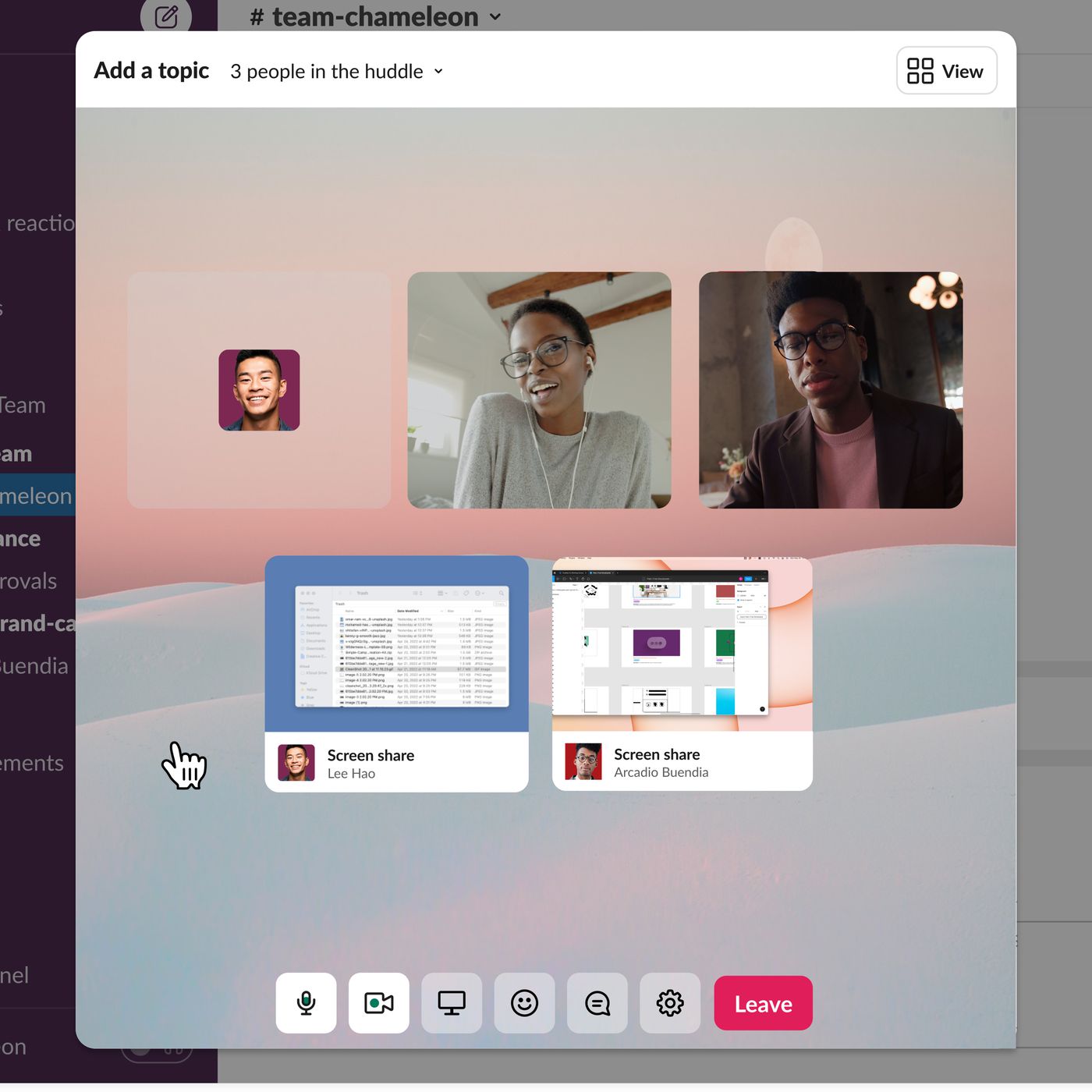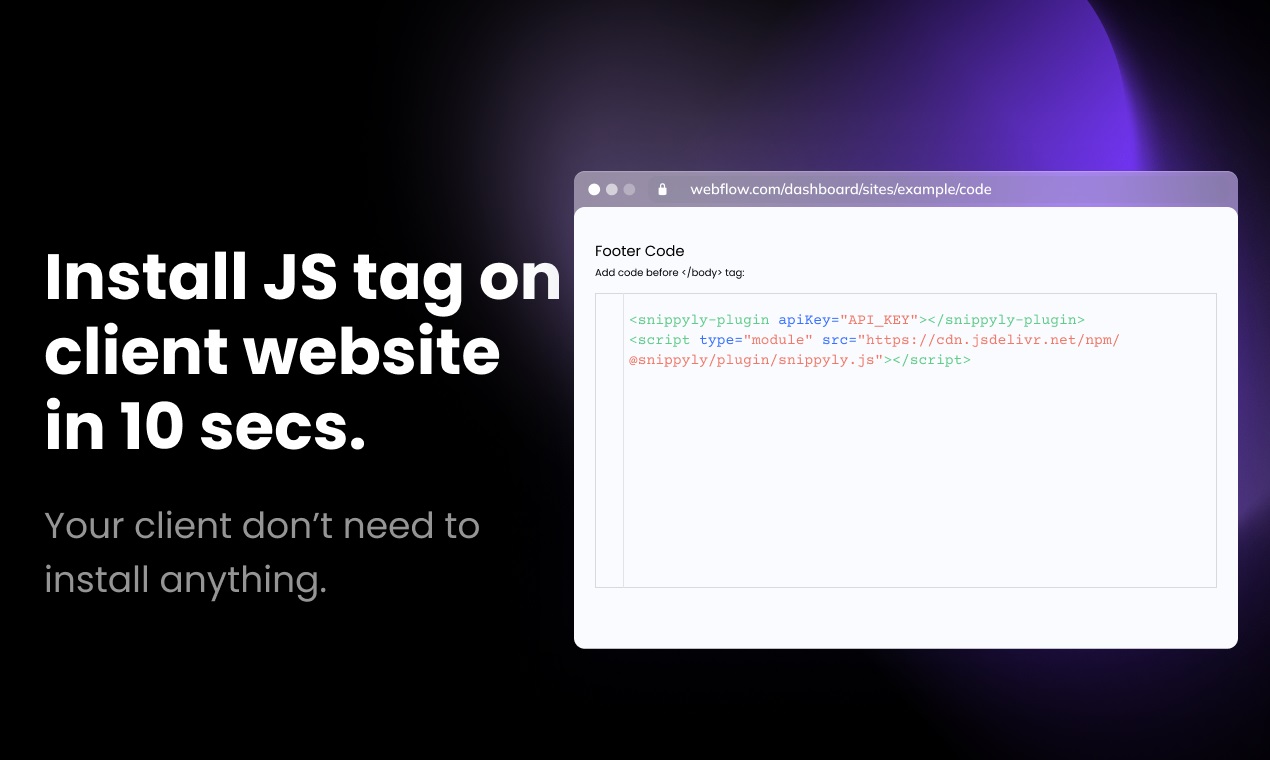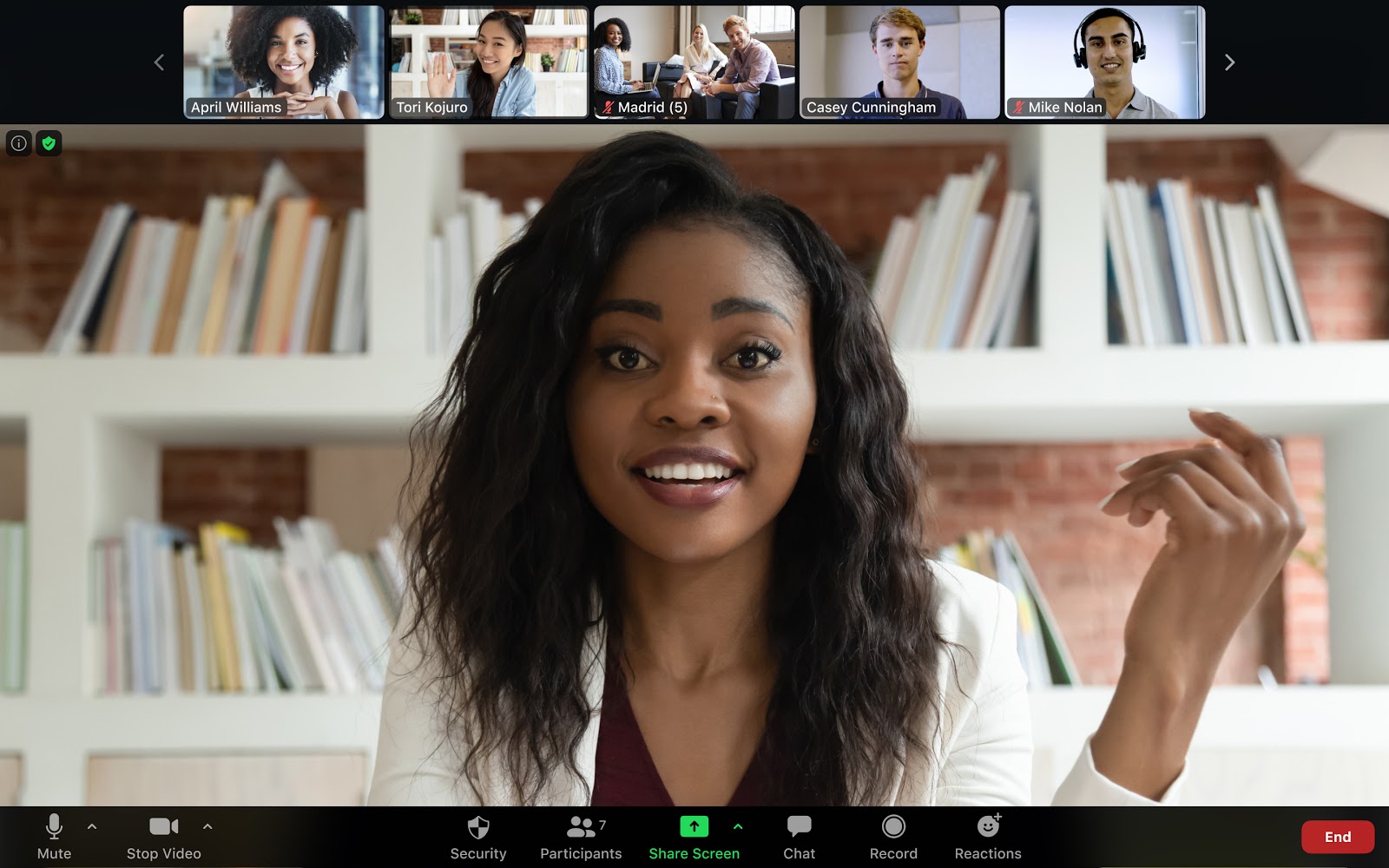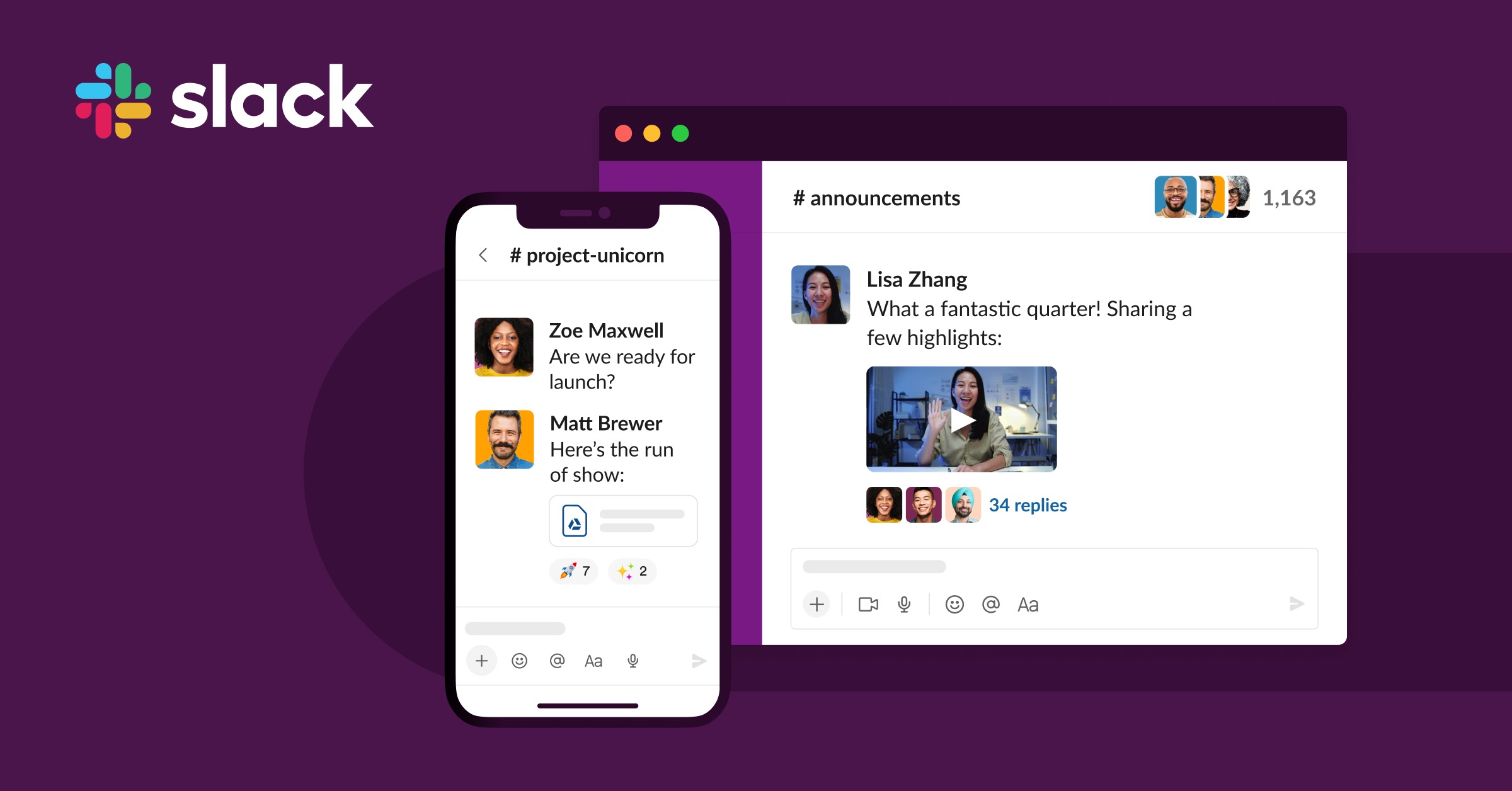Introduction
Welcome to the world of Slack huddles! Whether you’re a remote team, a distributed company, or just looking for an efficient way to communicate and collaborate with your team members, Slack huddles can revolutionize the way you work together. In this article, we’ll explore the ins and outs of starting a huddle in Slack, from setting up the platform to conducting effective discussions and assigning action items.
Slack has become a go-to platform for teams to connect and collaborate, providing a convenient and user-friendly interface for communication. One of the key features that sets Slack apart is its ability to create channels, which are dedicated spaces for different topics, projects, or teams. With a designated channel for your huddles, you can centralize discussions, keep track of information, and ensure that everyone is on the same page.
Starting a huddle in Slack is not just about having a quick meeting; it’s about fostering strong team communication and maximizing productivity. By following the steps outlined in this guide, you’ll be able to establish a structured and efficient huddle process that allows for effective collaboration and decision-making.
Throughout this article, we’ll explore the various aspects of starting a huddle in Slack, including creating a channel, inviting members, defining the purpose and goals of the huddle, scheduling and announcing huddle times, conducting the huddle itself, and reviewing and improving the huddle process. By the end, you’ll have all the knowledge you need to kickstart successful and engaging huddles with your team.
So, let’s dive in and discover how you can leverage Slack to facilitate seamless and productive huddles!
Setting Up Slack
Before you can start huddling in Slack, you need to set up your Slack workspace and familiarize yourself with its features. If you don’t already have a Slack account, you can easily sign up and create a new workspace.
Once you have your workspace, take the time to explore the different settings and preferences available. Customize your profile with a photo and a catchy bio to help your team members easily identify you. Familiarize yourself with the layout of the Slack interface, including the sidebar, channels, and direct messages.
Slack offers a variety of features and integrations that can enhance your huddle experience. Explore the app directory to find tools that can integrate with Slack and streamline your workflow. From project management apps to document collaboration tools, you’ll find a wide range of options to make your huddles more efficient and productive.
Moreover, Slack allows you to create multiple channels to organize your huddles effectively. Consider setting up separate channels for different teams, projects, or topics to ensure that conversations remain focused and organized. This way, team members can easily find relevant discussions and catch up on missed conversations.
As you set up your Slack workspace, it’s important to establish guidelines and best practices. Determine the dos and don’ts for using Slack within your team. This can include guidelines for channel etiquette, expected response times, and appropriate use of emojis, GIFs, and other forms of communication. Encouraging open and respectful communication within your workspace sets the stage for productive and engaging huddles.
Lastly, familiarize yourself with Slack’s notification settings. Adjusting these settings can help you stay informed without being overwhelmed by constant notifications. Customize your preferences so that you receive notifications for mentions, direct messages, and important updates, while minimizing unnecessary distractions during your huddles.
By taking the time to properly set up your Slack workspace and familiarize yourself with its features, you’ll be equipped with the tools you need to start huddling effectively with your team members. Now that you’re all set up, let’s move on to creating a channel for your huddles!
Creating a Channel
Creating a dedicated channel for your huddles is a crucial step in organizing and centralizing your discussions within Slack. Follow these steps to create a channel specifically for your huddles:
- On the Slack sidebar, click on the “+” symbol next to “Channels” to create a new channel.
- Give your channel a descriptive name that clearly indicates its purpose, such as “Huddle”, “Team Meeting”, or “Daily Check-In”.
- Consider adding a brief description to provide more context about the channel and its objectives. This can help new members understand the purpose of the huddles.
- If desired, choose whether the channel should be public or private. Public channels are accessible to all members, while private channels require an invitation to join.
- Once you’ve configured the channel settings, click on “Create” to finalize the creation of the channel.
Creating a dedicated channel for your huddles offers numerous benefits. It provides a designated space for huddle-related discussions, making it easier to find and refer back to important information and decisions. Additionally, having a separate channel allows team members who are not directly involved in the huddle to stay informed about ongoing discussions and outcomes.
When creating the channel, it’s important to consider who should have access to it. Generally, it’s a good practice to include all team members who are involved in or affected by the huddle topics. This ensures that everyone has access to information and can contribute to the conversation if necessary. However, for sensitive or confidential huddles, you may want to limit access to a select group of individuals.
As your huddles evolve and you establish regular meeting times, you can also consider creating recurring channels. These channels automatically reset at the start of each huddle, keeping the conversations focused and separate from previous discussions. Recurring channels help maintain clarity and prevent information overload, especially for long-running projects or ongoing discussions.
Creating a channel dedicated to your huddles in Slack is a fundamental step in streamlining communication and ensuring that important discussions are easily accessible. With the channel set up, it’s time to invite team members to join and actively participate in the huddles. Let’s explore how to invite members to the channel in the next section.
Inviting Members to the Channel
Once you’ve created a dedicated channel for your huddles, the next step is to invite team members to join. Inviting members to the channel ensures that everyone who needs to be involved or informed is part of the conversation. Follow these steps to invite members to your huddle channel:
- Open the huddle channel by clicking on its name in the Slack sidebar.
- Click on the channel settings icon (represented by a gear or three dots) and select “Invite More People” or a similar option.
- In the invitation window, you can start typing the names or email addresses of the team members you want to invite. Slack will suggest matching names from your workspace.
- Choose the appropriate team members from the suggestions or manually input their email addresses.
- Optionally, you can add a personalized message to the invitation, providing additional information or context about the huddle channel.
- Click on “Send” or a similar button to invite the selected team members to the channel.
Inviting members to the channel ensures that they have access to the discussions and can actively contribute to the huddles. It allows team members to stay informed, share their insights, and collaborate effectively towards achieving the huddle’s objectives.
When inviting members, it’s essential to be mindful of the individuals involved and the nature of the huddle. Consider inviting team members who can provide valuable input or are directly involved in the topics being discussed. It’s also important to strike a balance and avoid overwhelming the channel with unnecessary participants. Including relevant stakeholders helps maintain focused and productive discussions in the huddle channel.
In addition to inviting current team members, it’s crucial to ensure that new team members are also added to the huddle channel. This allows them to get up to speed quickly and provides them with an opportunity to share their insights and contributions right from the start.
Remember that inviting members to the huddle channel is just the beginning. Encourage active participation and engagement by setting clear expectations for team members. Clearly communicate the purpose and goals of the huddle channel and highlight the value of everyone’s input. This will help create an inclusive and collaborative environment where team members feel empowered to share their thoughts and ideas.
Now that your team members are invited to the huddle channel, it’s time to define the purpose and goals of the huddles themselves. We’ll explore this in the next section.
Defining the Purpose and Goals of the Huddle
Before you can conduct effective huddles in Slack, it’s important to clearly define the purpose and goals of each huddle. This sets the foundation for focused discussions and ensures that everyone understands the desired outcomes. Here are a few steps to help you define the purpose and goals of your huddle:
- Start by identifying the specific topic or objective that the huddle will address. Is it a project update, a brainstorming session, or a problem-solving discussion?
- Consider the desired outcomes or deliverables of the huddle. What do you hope to achieve by the end of the discussion? This could include making decisions, assigning tasks, or generating innovative ideas.
- Think about the target audience for the huddle. Who should be present and actively participating? Determine the key stakeholders and ensure their involvement.
- Outline the agenda or discussion points for the huddle. Break down the topic into subtopics or questions to guide the conversation and keep it on track.
- Set a timeframe for the huddle. Determine the ideal duration based on the complexity of the topic and the availability of team members. Consider scheduling shorter, more frequent huddles for ongoing projects or longer, more in-depth huddles for comprehensive discussions.
- Communicate the purpose, goals, and agenda of the huddle to the team members. This can be done through a pre-huddle announcement or a shared document that provides context and expectations.
Defining the purpose and goals of your huddle promotes clarity and ensures that everyone is aligned on the desired outcomes. It helps keep discussions focused, avoids unnecessary tangents, and maximizes the time spent during the huddle.
When defining the purpose and goals, it’s important to encourage open communication and input from team members. Emphasize the collaborative nature of the huddle and create an environment where diverse perspectives and ideas are valued. This will foster engagement and empower team members to actively contribute to achieving the desired goals.
Additionally, revisit the purpose and goals of the huddle periodically to ensure they remain relevant and aligned with the team’s objectives. As projects progress or new challenges arise, the purpose and goals of the huddle may need to be adjusted to reflect the evolving needs of the team.
Now that you have a clear understanding of the purpose and goals of your huddle, it’s important to establish guidelines that will help facilitate productive and respectful discussions. In the next section, we’ll explore how to establish huddle guidelines in Slack.
Establishing Huddle Guidelines
Setting clear guidelines for your huddles in Slack is essential to ensure that discussions are productive, respectful, and inclusive. These guidelines help create a positive and efficient huddle environment. Consider the following steps when establishing huddle guidelines:
- Start by defining expectations for active participation. Encourage team members to come prepared, actively listen, and contribute their ideas and insights during the huddle. Reinforce the importance of everyone’s input in fostering a collaborative environment.
- Establish guidelines for respectful communication. Emphasize the need for respectful and constructive feedback, both in person and in written form. Encourage team members to use positive language, avoid personal attacks, and be mindful of their tone when expressing opinions.
- Set guidelines for time management. Stress the importance of starting and ending huddles on time to respect everyone’s schedules. Encourage participants to stay focused and avoid unrelated discussions that may derail the huddle.
- Define the role of the huddle facilitator. Identify who will be responsible for leading and guiding the discussions in each huddle. Clearly communicate their role as a facilitator, ensuring that they create space for everyone to participate and manage the flow of the conversation.
- Encourage active listening. Emphasize the importance of providing equal opportunity for all team members to speak and be heard. Encourage participants to actively listen to others and avoid interrupting or dominating the conversation.
- Address any specific guidelines or norms relevant to your team or company culture. Consider including guidelines for using Slack features, such as the appropriate use of emojis, GIFs, and other forms of communication. Reinforce the importance of maintaining professionalism and inclusivity within the huddle.
By establishing clear huddle guidelines, you create a shared understanding of the expected behavior and communication norms within the team. This helps foster a positive and collaborative environment where team members feel respected and valued.
It’s important to revisit the huddle guidelines periodically to assess their effectiveness and make any necessary adjustments. Encourage feedback from team members regarding the guidelines and actively incorporate their suggestions to continuously improve the huddle experience.
With the huddle guidelines in place, it’s time to schedule and announce huddle times to ensure that team members are aware of the upcoming discussions. We’ll explore this topic in the next section.
Scheduling and Announcing Huddle Times
One of the key elements in successful huddle management is scheduling and announcing the huddle times in advance. This ensures that team members can plan their schedules accordingly and allocate dedicated time for the huddles. Follow these steps to effectively schedule and announce huddle times in Slack:
- Consider the availability of your team members and choose a time that works best for everyone. Take into account different time zones and any scheduling constraints that may exist. It is ideal to find a time that accommodates as many team members as possible.
- Determine the frequency of the huddles based on the nature of the project or discussions. For ongoing projects, daily or weekly huddles may be necessary. For more sporadic meetings, huddles may be scheduled as needed.
- Select a consistent day and time that promotes reliability and ensures that team members can plan their schedules accordingly. Having a predictable schedule helps create a routine and encourages consistent participation.
- Create a recurring event in your team’s shared calendar tool, such as Google Calendar or Outlook, to block off the huddle time. This allows everyone to have a clear view of the upcoming huddles and avoid scheduling conflicts.
- Announce the huddle times to team members through Slack. Consider using the huddle channel or a dedicated announcement channel to communicate the date, time, and duration of the huddles. Include any relevant agenda items or discussion topics to give team members an idea of what to expect.
- If your team members have differing availability, consider using tools like Doodle or a scheduling app integrated with Slack to find the most convenient time for everyone. These tools can help you coordinate and determine the optimal huddle time based on team member responses.
Scheduling and announcing huddle times in advance is crucial to ensure that team members are prepared and can actively participate in the discussions. By providing the schedule ahead of time, team members can plan their day accordingly, set aside the necessary time for the huddles, and come prepared with their input and updates.
When announcing the huddle times, encourage team members to add the huddles to their personal calendars to ensure they are reminded of the upcoming discussions. This helps reduce the chance of missed huddles and allows for better attendance and engagement.
Remember to be flexible and open to adjusting the huddle times as needed. Circumstances or scheduling conflicts may arise, so it’s important to facilitate open communication and find alternative times that work for everyone whenever possible.
Now that you have scheduled and announced the huddle times, it’s time to dive into the huddle itself and learn how to conduct effective discussions. We’ll explore this in the next section.
Conducting the Huddle
Once the huddle time arrives, it’s important to conduct the meeting in an organized and efficient manner to maximize productivity. In this section, we’ll explore best practices for conducting effective huddles in Slack:
- Start the huddle on time. Begin the meeting promptly to respect everyone’s time and set the precedent for punctuality. This shows that the huddles are valued and encourages team members to come prepared.
- Set the agenda and goals. Recap the purpose and goals of the huddle to ensure everyone is aligned and on the same page. Review the agenda or discussion points to guide the conversation and maintain focus.
- Encourage equal participation. Create an inclusive environment where all team members feel comfortable and encouraged to contribute. Promptly invite individuals to share their thoughts and ideas, ensuring that no one dominates the conversation.
- Use Slack features effectively. Make use of the various features in Slack to enhance the huddle experience. Utilize threads for side discussions or subtopics to keep the main channel focused. Leverage emojis for quick reactions or to gauge agreement or disagreement.
- Facilitate effective communication. As the huddle leader, ensure smooth and structured communication. Encourage active listening and provide space for team members to ask questions or seek clarification. Pay attention to any non-verbal cues in Slack, such as the use of emojis or typing indicators.
- Stay on track and manage time. As the facilitator, it’s crucial to keep the huddle on track and effectively manage time. Address any tangents or side discussions that may arise and gently steer the conversation back to the main agenda items. Be mindful of time constraints and allocate adequate time to each agenda item.
- Take breaks if needed. If the huddle is lengthy or involves intense discussions, consider scheduling short breaks to allow team members to refresh and refocus. This helps maintain engagement and prevents fatigue.
- Encourage note-taking. Assign someone, whether it’s the facilitator or a designated note-taker, to capture important discussion points, decisions, and action items. These notes can later be shared with the team for reference and accountability.
- Conclude with a summary. Before wrapping up the huddle, summarize the key outcomes, decisions, and action items. Ensure that every team member is clear on their next steps and responsibilities.
Conducting the huddle in an organized and respectful manner ensures that discussions are productive and impactful. By following these best practices, you’ll create a collaborative environment where team members feel valued and engaged.
Remember that effective huddle management is a continuous process of improvement. Regularly gather feedback from team members and assess the efficiency of the huddle process. Make adjustments and refine your approach to ensure that the huddles continue to meet the needs of the team.
With the huddle successfully conducted, it’s time to review and act on the discussed topics. In the next section, we’ll explore how to take notes and assign action items during the huddle.
Facilitating Effective Discussions
A key aspect of conducting successful huddles in Slack is the ability to facilitate effective discussions. As the huddle leader, your role is to guide the conversation, encourage participation, and ensure that the discussions remain focused and productive. Here are some tips to facilitate effective discussions:
- Set clear objectives: Clearly communicate the purpose and goals of the discussion to the team members at the beginning of the huddle. This helps everyone understand what needs to be achieved and keeps the conversation on track.
- Active listening: Encourage active listening among team members. This means paying attention to what others are saying, refraining from interrupting, and seeking clarification when needed. Acknowledge and validate different perspectives to foster a respectful and collaborative environment.
- Prompt questions and encourage input: Ask open-ended questions to promote engagement and encourage team members to share their thoughts and ideas. Create an inclusive atmosphere where everyone feels comfortable contributing. Use the @mention feature in Slack to address specific team members and gather their input on relevant topics.
- Maintain focus: Keep the discussions focused on the agenda items and avoid going off-topic. If a side discussion arises, consider suggesting a separate thread or a dedicated channel for further exploration while ensuring that the main discussion remains on track.
- Encourage constructive debate: Healthy debate can lead to new insights and creative solutions. Create an environment where team members feel comfortable challenging ideas and engaging in constructive discussions. Set the expectation that all opinions are welcome as long as they are presented respectfully.
- Manage time effectively: Time management is crucial during huddles. Allocate sufficient time to each agenda item and ensure that discussions do not overrun. If necessary, table certain topics for later discussion to maintain the flow of the huddle.
- Summarize and synthesize: Periodically summarize key points, decisions, and action items. This helps ensure that everyone is on the same page and understands the progress made during the huddle. Synthesize the information shared to distill key insights and provide clarity.
- Address conflicts constructively: In the event of conflicts or differing opinions, facilitate a constructive resolution. Encourage compromise and finding common ground while respecting different viewpoints. Explore potential solutions together as a team.
- Use visual aids and media: Utilize visual aids, such as graphs, charts, or shared documents, to enhance understanding and foster engagement. Incorporate multimedia elements like images or videos when relevant to convey ideas effectively.
Facilitating effective discussions requires a balance of leadership, active listening, and creating a safe space for open dialogue. By applying these techniques, you can ensure that your huddles in Slack are engaging, productive, and contribute to the overall success of your team.
Now that you have facilitated a fruitful discussion, it’s crucial to document the outcomes and assign action items. In the next section, we will explore the importance of taking notes and assigning tasks during the huddle.
Taking Notes and Assigning Action Items
Taking notes and assigning action items during a huddle is essential for capturing important discussions, decisions, and next steps. It ensures that the outcomes of the huddle are documented and that responsibilities are clearly assigned. Follow these guidelines for effective note-taking and action item assignment:
- Designate a note-taker: Assign someone in the huddle, whether it’s the facilitator or a designated team member, to take notes. Having a dedicated note-taker allows others to fully engage in the discussion without worrying about capturing every detail.
- Use a shared document or collaborative note-taking tool: Utilize a shared document or a collaborative note-taking tool like Google Docs or Evernote to capture the key points discussed during the huddle. This allows team members to access and refer to the notes later on.
- Outline discussion points: Organize the notes based on the agenda items or discussion points. Create clear headings or sections to make it easier for team members to navigate and reference specific topics.
- Record key decisions: Summarize any decisions made during the huddle, including their context and rationale. Clearly document any actionable items arising from the discussions.
- Assign responsibilities: For each action item, assign a responsible team member and indicate the deadline or timeline for completion. Clearly state what needs to be done, by whom, and by when to avoid confusion or delays.
- Indicate follow-up actions: Note any follow-up actions that need to be taken outside of the huddle, such as scheduling additional meetings, conducting further research, or contacting external stakeholders.
- Capture open questions or unresolved issues: If there are any open questions or topics that require further exploration or discussion, ensure they are documented. This helps to ensure that no important points are overlooked and that follow-up discussions can take place if needed.
- Share the notes: Once the huddle concludes, share the notes with all relevant team members. This can be done by sharing the document or note-taking tool link in the huddle channel or by sending it via direct message. This allows everyone to review and refer back to the discussions and action items.
- Encourage feedback and clarification: Invite team members to review the notes and provide any necessary feedback or clarification. This promotes accountability and ensures that everyone has a shared understanding of the discussed topics and next steps.
By taking thorough and detailed notes and assigning clear action items, you create a roadmap for the team to follow after the huddle. It helps prevent misunderstandings, ensures accountability, and keeps everyone aligned on the tasks at hand.
Remember to periodically revisit the notes and action items to track progress and update status. This allows for ongoing collaboration, troubleshooting, and adjustment as needed.
Now that you’ve taken notes and assigned action items, it’s crucial to wrap up the huddle in a productive and efficient manner. In the next section, we’ll explore how to effectively wrap up your huddles in Slack.
Wrapping Up the Huddle
As the huddle comes to a close, it’s essential to wrap up the meeting in a productive and efficient manner. Wrapping up effectively ensures that team members leave with a clear understanding of the discussed topics and action items. Follow these guidelines to wrap up your huddles in Slack:
- Summarize key points and decisions: Provide a concise summary of the main takeaways from the huddle. Highlight any key decisions made or agreements reached during the discussion. This summary serves as a reminder of the progress made and ensures that everyone is on the same page.
- Review assigned action items: Go through the list of assigned action items and verify that each task has been clearly assigned to a responsible team member. Double-check deadlines and ensure that there is a shared understanding of what needs to be done.
- Address any questions or concerns: Before concluding the huddle, give team members a chance to ask any remaining questions or express any concerns. Address these queries to ensure that everyone has a clear understanding and is comfortable with the discussed topics and action items.
- Set expectations for follow-up: Clarify what will happen after the huddle. Communicate any subsequent steps, such as sharing the meeting notes or scheduling a follow-up discussion. Providing this information helps set expectations and ensures that the momentum from the huddle carries forward.
- Express gratitude and appreciation: Take a moment to express your gratitude and appreciation for everyone’s participation and contribution. Acknowledge the valuable insights and ideas shared during the huddle. This fosters a positive and collaborative environment within the team.
- Officially end the huddle: Clearly communicate that the huddle has come to an end and thank team members for their time and input. Encourage team members to continue the conversation in the designated huddle channel or in any follow-up discussions that may be scheduled.
By wrapping up the huddle effectively, you create a sense of closure and ensure that everyone leaves with a clear understanding of the discussed topics and action items. This helps maintain productivity and accountability as team members move forward with their assigned tasks.
Remember to promptly share the meeting notes and any relevant documents or resources with the team members. This allows them to refer back to the discussion and carry out their assigned responsibilities effectively.
With the huddle successfully wrapped up, it’s crucial to periodically review and improve the huddle process. In the next section, we’ll discuss the importance of reviewing and continuously improving the huddle process in Slack.
Reviewing and Improving the Huddle Process
Regularly reviewing and improving the huddle process is essential to ensure that it remains effective and aligned with the needs of the team. By continuously assessing and refining the huddle process, you can optimize team productivity and foster a culture of continuous improvement. Here are some steps to review and improve the huddle process:
- Gather feedback from team members: After each huddle, solicit feedback from the participants. Ask for their thoughts on the effectiveness of the huddle, areas for improvement, and any suggestions they may have. This helps to identify strengths and weaknesses of the current process.
- Assess meeting objectives and outcomes: Reflect on the objectives set for each huddle and evaluate whether they were achieved. Assess whether the desired outcomes were met and if the discussions were focused and productive. Identify any gaps or areas where the huddle process can be refined.
- Evaluate time management: Review the duration of the huddles to ensure that the allocated time is sufficient for the agenda items. Assess whether any agenda items consistently required more time than anticipated or if unnecessary time was spent on certain topics. Adjust the time allocation accordingly.
- Analyze participant engagement: Gauge the level of engagement and participation from team members during the huddles. Consider if everyone was actively involved and if there were any individuals who seemed less engaged. Explore ways to encourage equal participation and ensure that all voices are heard.
- Review action item progress: Assess the progress of the assigned action items from previous huddles. Determine if they were completed within the agreed-upon timelines and if the outcomes were achieved. Identify any barriers or challenges that hindered progress and find solutions to overcome them.
- Seek opportunities for improvement: Look for any recurring issues or pain points within the huddle process. Identify patterns or bottlenecks that could be addressed to enhance efficiency and collaboration. Brainstorm potential solutions and implement changes that can improve the overall huddle experience.
- Communicate changes and seek buy-in: If you make changes to the huddle process based on the feedback and assessments, communicate these changes to the team. Explain the rationale behind the adjustments and ensure that everyone understands and supports the updated approach.
- Continuously iterate and adapt: Recognize that the huddle process is dynamic and should evolve over time. Encourage the team to provide ongoing feedback and make regular assessments. Embrace a culture of continuous improvement, where the huddle process is continuously refined to meet the changing needs of the team.
By reviewing and improving the huddle process, you can enhance team collaboration, productivity, and engagement. Implement feedback-driven changes and track the impact of these adjustments to ensure that they result in meaningful improvements. Regularly revisit the huddle process and strive for continuous growth and optimization.
Remember that every team is unique, and the huddle process should be tailored to fit your specific needs and objectives. Use the feedback and assessments as a foundation for creating a huddle process that empowers your team to collaborate effectively and achieve their goals.
With the huddle process continually improving, your team will experience more efficient and productive discussions, ultimately leading to success in your projects and initiatives.

























